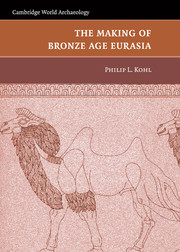Book contents
- Frontmatter
- Contents
- Illustrations and Maps
- Abbreviations
- Preface
- Frontispiece: Eurasian Steppe Zone and the Greater Ancient Near East
- 1 Archaeological Theory and Archaeological Evidence
- 2 The Chalcolithic Prelude – From Social Hierarchies and Giant Settlements to the Emergence of Mobile Economies, ca. 4500–3500 BC
- 3 The Caucasus – Donor and Recipient of Materials, Technologies, and Peoples to and from the Ancient Near East
- 4 Taming the Steppe – The Development of Mobile Economies: From Cattle Herders with Wagons to Horseback Riders Tending Mixed Herds; the Continued Eastward Expansion of Large-Scale Metallurgical Production and Exchange
- 5 Entering a Sown World of Irrigation Agriculture – From the Steppes to Central Asia and Beyond: Processes of Movement, Assimilation, and Transformation into the “Civilized” World East of Sumer
- 6 The Circulation of Peoples and Materials – Evolution, Devolution, and Recurrent Social Formations on the Eurasian Steppes and in West Asia: Patterns and Processes of Interconnection during Later Prehistory
- Appendix
- References
- Index
1 - Archaeological Theory and Archaeological Evidence
Published online by Cambridge University Press: 05 June 2012
- Frontmatter
- Contents
- Illustrations and Maps
- Abbreviations
- Preface
- Frontispiece: Eurasian Steppe Zone and the Greater Ancient Near East
- 1 Archaeological Theory and Archaeological Evidence
- 2 The Chalcolithic Prelude – From Social Hierarchies and Giant Settlements to the Emergence of Mobile Economies, ca. 4500–3500 BC
- 3 The Caucasus – Donor and Recipient of Materials, Technologies, and Peoples to and from the Ancient Near East
- 4 Taming the Steppe – The Development of Mobile Economies: From Cattle Herders with Wagons to Horseback Riders Tending Mixed Herds; the Continued Eastward Expansion of Large-Scale Metallurgical Production and Exchange
- 5 Entering a Sown World of Irrigation Agriculture – From the Steppes to Central Asia and Beyond: Processes of Movement, Assimilation, and Transformation into the “Civilized” World East of Sumer
- 6 The Circulation of Peoples and Materials – Evolution, Devolution, and Recurrent Social Formations on the Eurasian Steppes and in West Asia: Patterns and Processes of Interconnection during Later Prehistory
- Appendix
- References
- Index
Summary
Cultural change or cultural evolution does not operate on isolated societies but always on interconnected systems in which societies are variously linked within wider ‘social fields.’
E. R. Wolf (1982: 76)Archaeologists gather data about the past and interpret it within distinct research traditions that structure the data they select to find and analyze, and that provide them with the necessary support to carry on their work. The activity of reconstructing the past through the analysis of material cultural remains is necessarily constrained by the social context in which the archaeologist must function. This observation is self-evident, but, during the past twenty years or so, there has been an increasing recognition that these separate traditions of research divide themselves along cultural, linguistic, and, most interestingly, national lines. This too is not surprising, particularly when one considers the very practical nature of conducting archaeological research, that is, obtaining financial support, typically or at least in part, from the state to excavate sites that are now nearly universally considered to form part of some state's – usually the archaeologist's own – national heritage or patrimony. That there exist national traditions of archaeological research also is not surprising when one examines the historical development of the discipline: rooting a people or a nation in the distant past was one of the main stimuli for the development of archaeology, particularly prehistoric archaeology, during the past two hundred years or, not coincidentally, during the period that witnessed the rise of modern nation-states as the world's fundamental unit of political organization.
- Type
- Chapter
- Information
- The Making of Bronze Age Eurasia , pp. 1 - 22Publisher: Cambridge University PressPrint publication year: 2007

